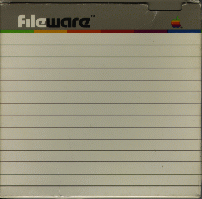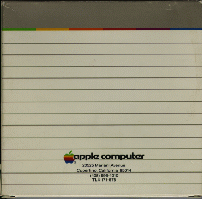

The Twiggy floppy drive was a double-sided drive, but unlike conventional double-sided drives the heads were not directly opposing. Instead the heads were on opposite sides of the spindle, and opposing each head was a pressure pad (as commonly used in single-sided drives). This was supposed to reduce head wear. It also meant that the stiff jackets of the floppy media had to have non-standard cutouts. The write-protect cutout was moved to the side of the disk that would be nearest the back of the drive. One corner of the disk was notched for "keying" to prevent the user from inserting the disk incorrectly. A rectangular hole near that corner was apparently for use to latch the disk in the drive, preventing the user from removing it while it was in an inconsistent state.
Also, rather than spining the disk at the then-standard 300 RPM, they adjusted the speed based on the cylinder being accessed, from 218 to 320 RPM. This allowed the storage of more sectors per track on the outer tracks, while using a roughly constant peak FCPI (flux changes per inch) on all tracks. Normal floppy disks use constant rotation and data rates, and effectively waste much of the storage capacity of the outer tracks. Modern hard disks vary the data rate and keep the rotation rate constant.
Note that since the heads were on opposite sides of the spindle, but moved by the same actuator mechanism, when one head is near the center the other is near the edge. Thus, it is not possible to rapidly switch sides of the media. For normal double-sided drives the optimum order is to read both sides of each cylinder before moving the positioner to the next track. On the Twiggy drive it was faster to read one entire side, then the other.
Apple used a track pitch of 62.5 TPI, rather than the standard 48 TPI or 96 TPI. I suspect that they were able to achieve 62.5 TPI using the same heads that would normally be used for 48 TPI, rather than the narrow-gap heads used for 96 TPI.
Through the use of double-sided media, the higher track pitch, variable motor speed, and GCR recording, Apple achieved a storage capacity of 871,424 byte per diskette, a six-fold improvement over the earlier single-sided Disk ][ and Disk /// drives had a capcity of 143,360 bytes.
My experimentation indicates that media formulation was apparently similar if not identical to the media later adopted for "high-density" (1.2 MB) 5.25 inch drives (first commonly used in the IBM PC-AT). Before I acquired a supply of Twiggy diskettes for my Lisa 1, I made a few by very laboriously modifying 1.2 MB diskettes.
Apple trademarked the term "FileWare" to refer to the Twiggy disks. Apple announced but never shipped the UniFile and DuoFile products, which were single and dual Twiggy drives for the Apple ][ and Apple ///. The drives were only used in the original Lisa computer.
Apple also used the Twiggy drive in the early Macintosh prototypes, as shown in this picture, courtesy of Joseph Liberto of VirtuosoDesign. By the time the Macintosh was introduced in 1984 they had switched to a Sony 400 KB single-sided 3.5 inch drive. While the Sony drive was custom-built to Apple specifications using the variable motor speed and motorized disk ejection, it used standard media and the standard track pitch of 135 TPI.
The Sony drive was so much more reliable than the Twiggy that Apple designed it into the Lisa 2, and offered a free upgrade from the Lisa 1 to the Lisa 2. Consequently the Lisa 1 has become quite a rarity.
Unfortunately it is difficult to see the head and index holes in the diskette jackets. You may have to adjust your monitor.
 Back to my Lisa page
Back to my Lisa page
 Back to my Retrocomputing page
Back to my Retrocomputing page
 Back to my home page
Back to my home page
Last updated July 1, 2019
Copyright 1996, 1997, 1998, 1999, 2019 Eric Smith
This document may not be reproduced by any means, in whole or in part,
without the written consent of the author.
All trademarks are property of their respective owners.